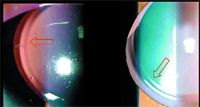Article
Posterior chamber toric ICL tackles compound myopic astigmatism
Implantation of a toric implantable contact lens for compound myopic astigmatism seems to be very effective, highly predictable, and relatively safe. A widely dilated pupil is very important, especially in the implantation of a toric lens, to align the axes properly. In the case of improper alignment of axes, repositioning of the lens is easy and safe.

Key Points

He and his colleagues conducted a prospective study in which they sought to assess the efficacy, predictability, and safety of posterior chamber toric phakic lenses for compound myopic astigmatism. The study patients all were aged at least 21 years and had a stable manifest refraction for at least 1 year before the surgery. The baseline manifest refractive spherical equivalent ranged from –5.0 to –15.0 D of myopia, and the cylinder ranged from 1.0 to 6.0 D. The preoperative best-corrected visual acuity in all patients was 20/20.
Patients with keratoconus or those suspected of having keratoconus were excluded based on the results of videokeratography. Eyes with an endothelial cell count in the central cornea of 2,200 cells/mm2 also were excluded. All patients had an anterior chamber depth of 2.7 mm or more. Dr. El-Danasoury is medical director and chief of refractive surgery at Magrabi Hospital, Jeddah, Saudi Arabia.
Sulcus-supported lens
A specific sulcus-supported design of the lens (V4) was used, according to Dr. El-Danasoury. The lens is made of hydrophilic collagen and measures 12 to 13.5 mm in length. All lenses were implanted via a clear temporal corneal incision with patients under topical anesthesia.

After the lens is loaded into the cartridge, it is injected very slowly into the eye. The lens starts to unfold outside the cartridge while the leading part of the lens is still in the cartridge, eliminating the possibility of the lens being upside down. Once the lens is inside the anterior chamber, the proximal haptics are inserted through the main temporal incision under the iris using a lens manipulator. Then a side port is created with a sharp knife and the manipulator is used to position the leading haptic gently under the iris.
Wide pupil dilation
Dr. El-Danasoury emphasized the importance of pupil dilation in this procedure. "The pupil should be widely dilated when implanting [this toric lens]. Wide pupil dilation is even more important than with a spherical ICL because the surgeon must be able to see the marks on the axis on the haptics. A very widely dilated pupil is necessary to achieve good centration of the ICL," he said.
Dr. El-Danasoury uses a vitrector for a peripheral iridectomy because he claims the procedure is "very helpful, very reproducible, and elegant." Also, he said he prefers a vitrector because it is more cosmetically appealing than a classic iridectomy done with forceps and scissors. This brings the procedure to a close.
Newsletter
Don’t miss out—get Ophthalmology Times updates on the latest clinical advancements and expert interviews, straight to your inbox.




